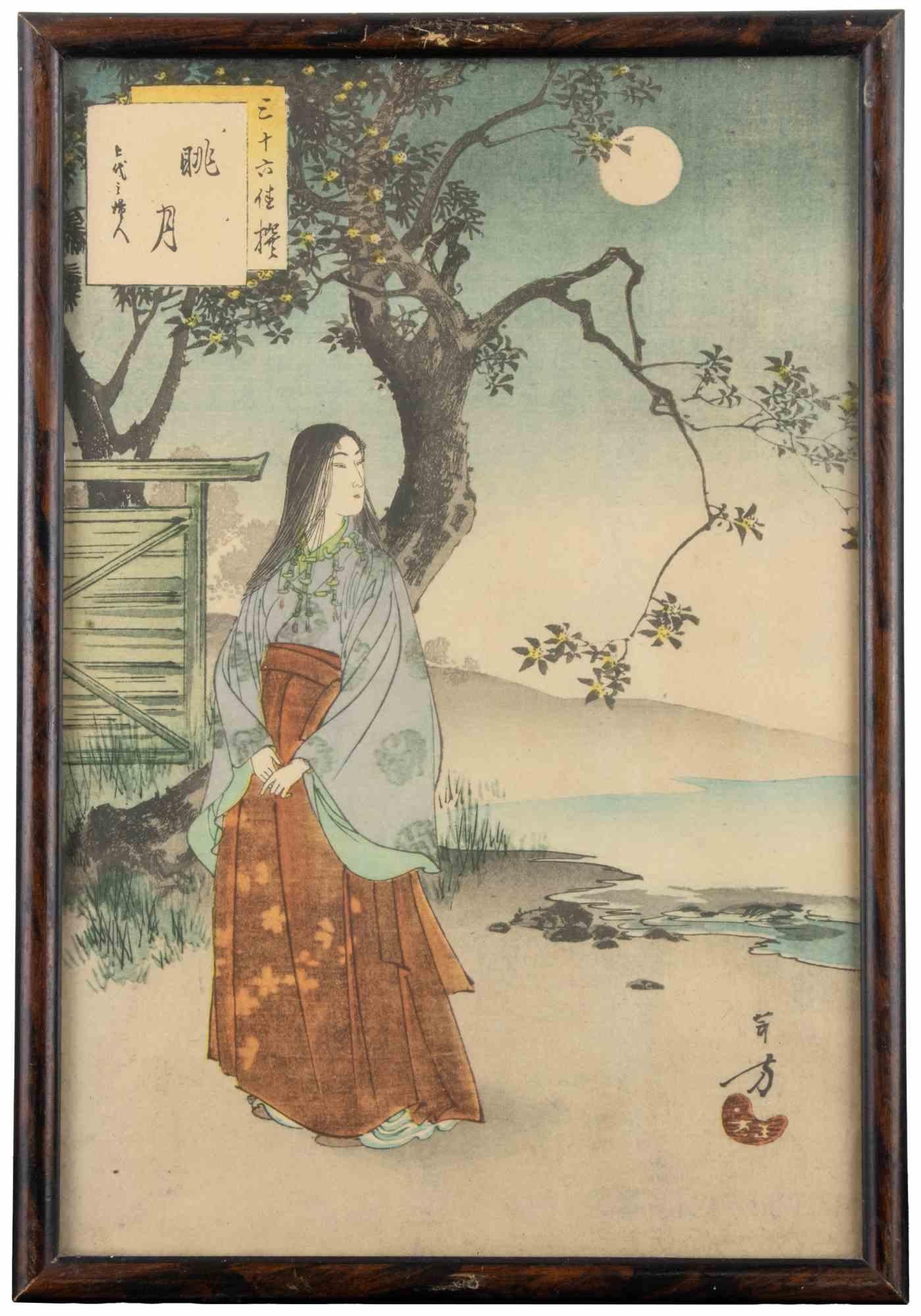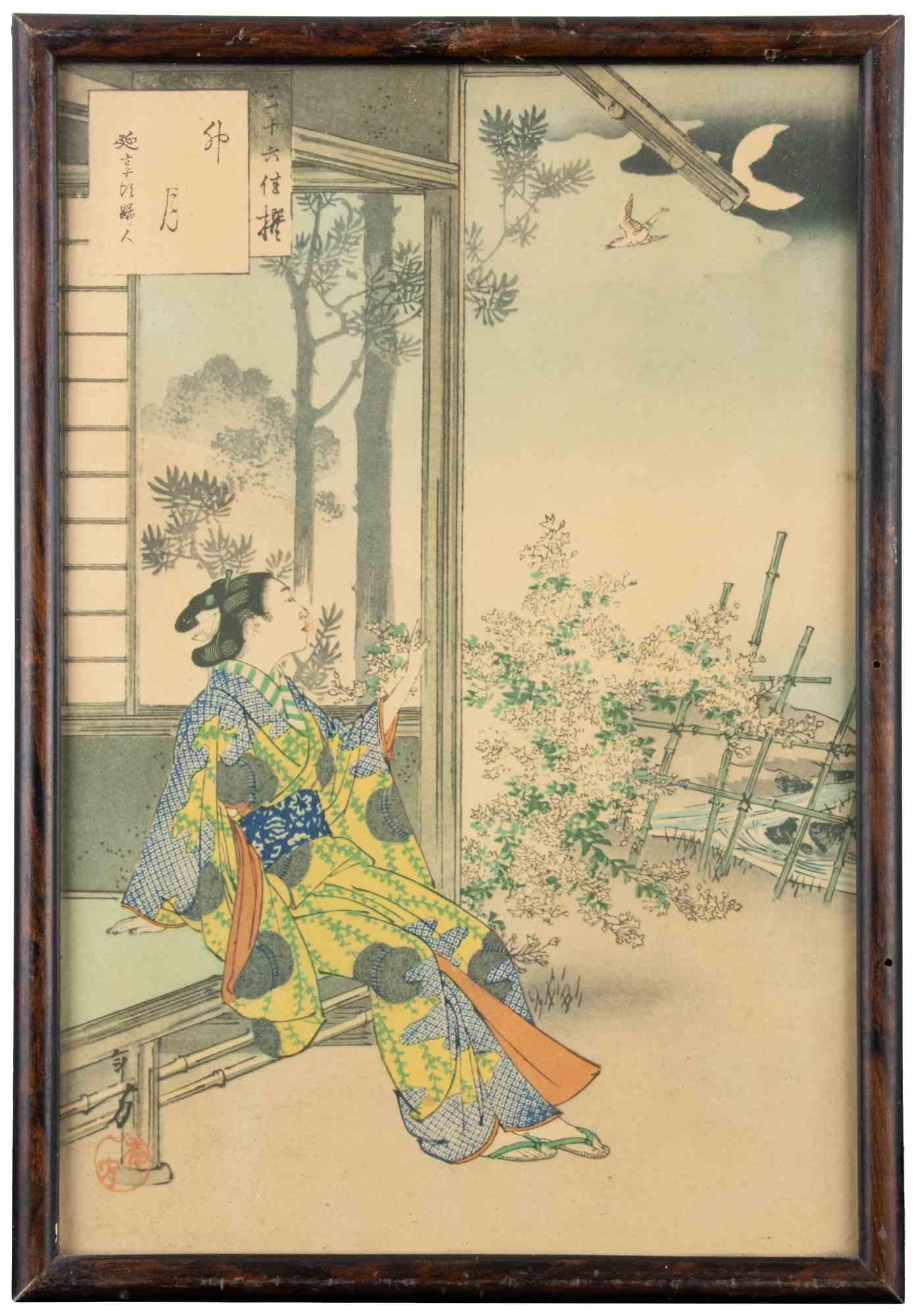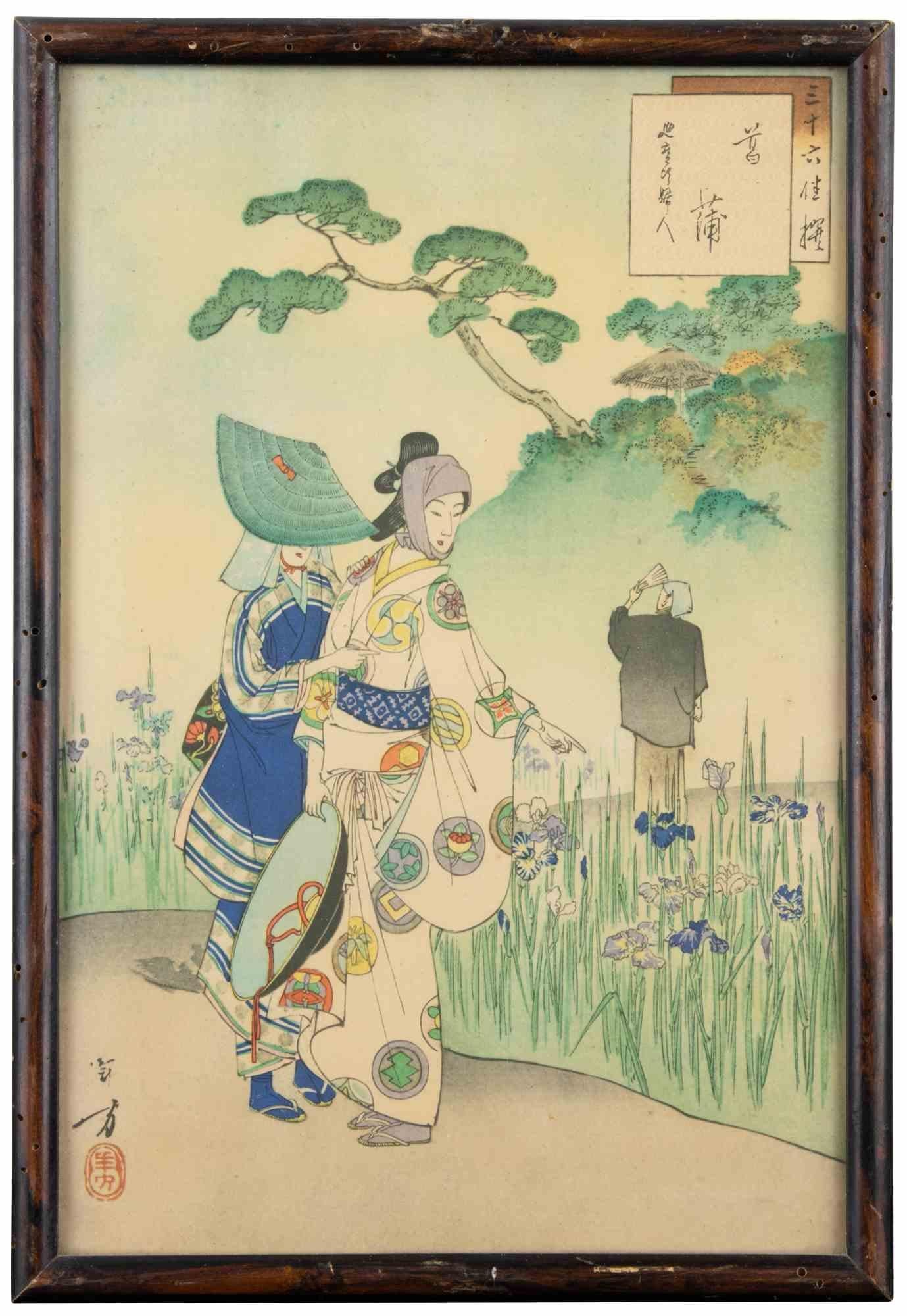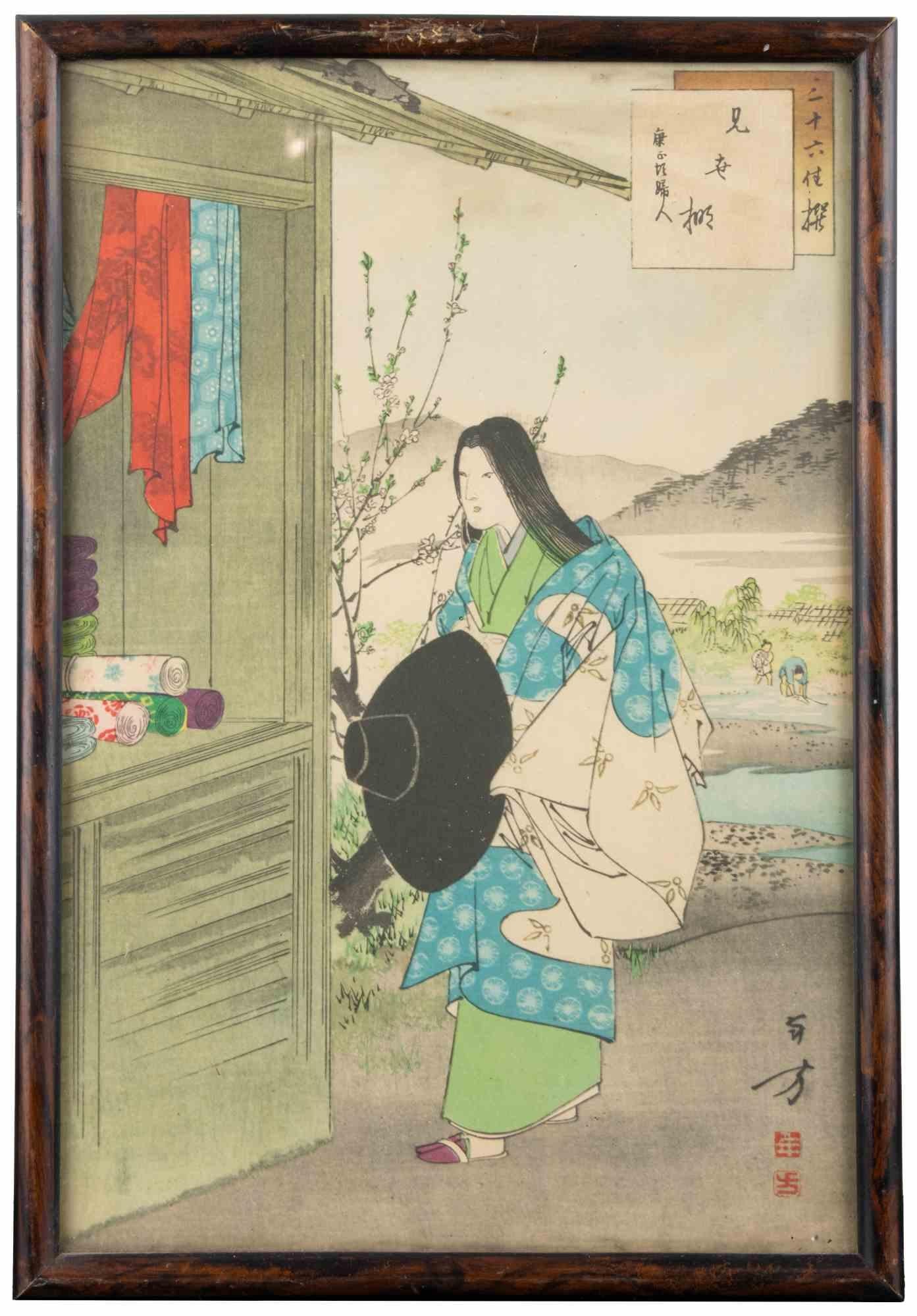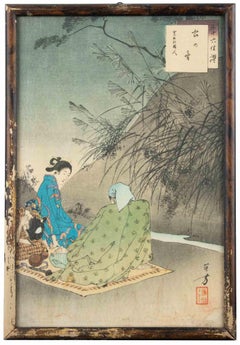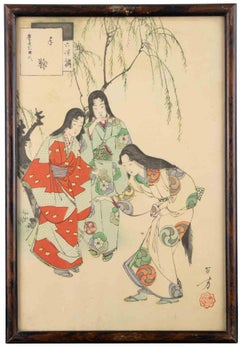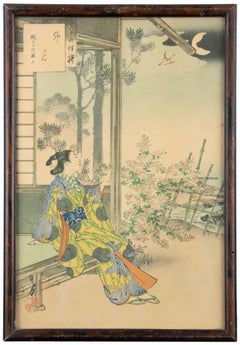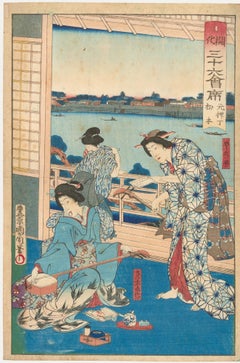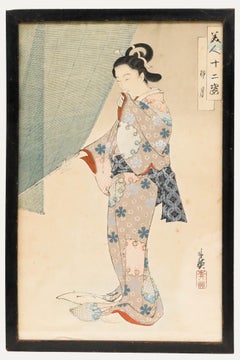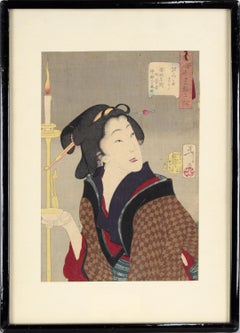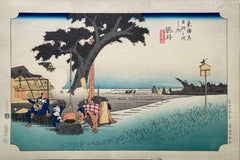Items Similar to The Art of Tea Ceremony for a Day - Woodcut by Mizuno Toshikata - 1890s
Want more images or videos?
Request additional images or videos from the seller
1 of 2
Mizuno ToshikataThe Art of Tea Ceremony for a Day - Woodcut by Mizuno Toshikata - 1890s1890s
1890s
$416.28
£310.03
€350
CA$583.85
A$640.43
CHF 330.25
MX$7,649.31
NOK 4,188.53
SEK 3,929.31
DKK 2,667.85
About the Item
Bijinga, The art of tea ceremony for a day is an original artwork realized in 1896 by Mizuno Toshikata (1866 - 1908).
Oban yokoe From the series "Chanoyu nichinichi gusa" (The art of tea ceremony for a day).
Arrival of one of the guests, in the garden blooming cherry trees.
Signed: Toshikata and seal Mizuno. Publisher: Akiyama Buemon.
Very good lifetime impression with blind printing (pattern in the woman's robe in front, cherry blossoms, shikishi leaf of the text), black glossy printing, backed, slightly faded, centerfold.
- Creator:Mizuno Toshikata (1866 - 1908)
- Creation Year:1890s
- Dimensions:Height: 8.67 in (22 cm)Width: 5.91 in (15 cm)Depth: 0.04 in (1 mm)
- Medium:
- Movement & Style:
- Period:
- Condition:Insurance may be requested by customers as additional service, contact us for more information.
- Gallery Location:Roma, IT
- Reference Number:Seller: T-1286641stDibs: LU65039380542
About the Seller
4.9
Platinum Seller
Premium sellers with a 4.7+ rating and 24-hour response times
1stDibs seller since 2017
7,756 sales on 1stDibs
Typical response time: 2 hours
- ShippingRetrieving quote...Shipping from: Monaco, Monaco
- Return Policy
Authenticity Guarantee
In the unlikely event there’s an issue with an item’s authenticity, contact us within 1 year for a full refund. DetailsMoney-Back Guarantee
If your item is not as described, is damaged in transit, or does not arrive, contact us within 7 days for a full refund. Details24-Hour Cancellation
You have a 24-hour grace period in which to reconsider your purchase, with no questions asked.Vetted Professional Sellers
Our world-class sellers must adhere to strict standards for service and quality, maintaining the integrity of our listings.Price-Match Guarantee
If you find that a seller listed the same item for a lower price elsewhere, we’ll match it.Trusted Global Delivery
Our best-in-class carrier network provides specialized shipping options worldwide, including custom delivery.More From This Seller
View AllSanjûroku Kasen ... - Woodcut by Mizuno Toshikata - 1893
By Mizuno Toshikata
Located in Roma, IT
Nishiki-e (woodcut print), in vertical oban format (31x20.5) realized by Mizuno Toshikata in 1893 (Meiji 26).
Belongs to the Series "Sanjûroku Kasen" (Thirty-Six Beauties in Compari...
Category
1890s Modern Figurative Prints
Materials
Woodcut
Sanjûroku Kasen... - Woodcut by Mizuno Toshikata - 1893
By Mizuno Toshikata
Located in Roma, IT
Nishiki-e (woodcut print), in vertical oban format (31x20.5) realized by Mizuno Toshikata in 1893 (Meiji 26).
Belongs to the Series "Sanjûroku Kasen" (Thirty-Six Beauties in Compari...
Category
1890s Modern Figurative Prints
Materials
Woodcut
Sanjûroku Kasen... - Woodcut by Mizuno Toshikata - 1893
By Mizuno Toshikata
Located in Roma, IT
Nishiki-e (woodcut print), in vertical oban format (31x20.5) realized by Mizuno Toshikata in 1893 (Meiji 26).
Belongs to the Series "Sanjûroku Kasen" (Thirty-Six Beauties in Compari...
Category
1890s Modern Figurative Prints
Materials
Woodcut
Sanjûroku Kasen ... - Woodcut by Mizuno Toshikata - 1893
By Mizuno Toshikata
Located in Roma, IT
Nishiki-e (woodcut print), in vertical oban format (31x20.5) realized by Mizuno Toshikata in 1893 (Meiji 26).
Belongs to the Series "Sanjûroku Kasen" (Thirty-Six Beauties in Compari...
Category
1890s Modern Figurative Prints
Materials
Woodcut
Sanjûroku Kasen ... - Woodcut by Mizuno Toshikata - 1893
By Mizuno Toshikata
Located in Roma, IT
Nishiki-e (woodcut print), in vertical oban format (31x20.5) realized by Mizuno Toshikata in 1893 (Meiji 26).
Belongs to the Series "Sanjûroku Kasen" (Thirty-Six Beauties in Compari...
Category
1890s Modern Figurative Prints
Materials
Woodcut
Sanjûroku Kase... - Woodcut by Mizuno Toshikata - 1893
By Mizuno Toshikata
Located in Roma, IT
Nishiki-e (woodcut print), in vertical oban format (31x20.5) realized by Mizuno Toshikata in 1893 (Meiji 26).
Belongs to the Series "Sanjûroku Kasen" (Thirty-Six Beauties in Compari...
Category
1890s Modern Figurative Prints
Materials
Woodcut
You May Also Like
Toyohara Kunichika (1835-1900) - Woodblock, Kawacho Restaurant at Asakusa
By Toyohara Kunichika
Located in Corsham, GB
A charming Japanese woodblock print depicting three geishas playing instruments in a Kawacho restaurant. From Kaika sanjuroku kaiseki (Thirty-six famous restaurants and views of civi...
Category
Late 19th Century Figurative Prints
Materials
Woodcut
Toshihide Migita (1863-1925) - Japanese Woodblock, Geisha
By Migita Toshihide
Located in Corsham, GB
This ukiyo-e print depicts a geisha elegantly adorned in traditional dress as she lifts the blinds. The work is from the series "Bijin Juni-shi" (The Twelve Figures of the Beauties) ...
Category
Late 19th Century Portrait Prints
Materials
Woodcut
"Thirsty: the appearance of a town geisha in the Ansei era" - Woodblock on Paper
By Tsukioka Yoshitoshi
Located in Soquel, CA
"Thirsty: the appearance of a town geisha in the Ansei era" - Woodblock on Paper
From the series "Thirty-two Aspects of Customs and Manners" (Fuzoku sanjuniso)
Lively woodblock of a...
Category
1880s Edo Figurative Prints
Materials
Paper, Ink, Woodcut
'Tea Stall at Fukuroi', After Utagawa Hiroshige 歌川廣重, Ukiyo-e Woodblock, Tokaido
By Utagawa Hiroshige (Ando Hiroshige)
Located in Santa Cruz, CA
An ink on paper, Nishiki-e and Yoko-e woodblock landscape showing a samurai and his porter enjoying the shade of a Japanese pine tree while waiting for tea, circa 1850. Signed in Kan...
Category
Mid-20th Century Landscape Prints
Materials
Sumi Ink, Washi Paper
"Pictures Of Noh" - 1922 Original Japanese Woodblock Print
Located in Soquel, CA
"Pictures Of Noh" - 1922 Original Japanese Woodblock Print
Original Japanese woodblock print by Tsukioka Kogyo (Japanese, 1869-1927...
Category
1920s Edo Figurative Prints
Materials
Ink, Rice Paper, Woodcut
'Hashirri Teahouse', After Utagawa Hiroshige 歌川廣重, Ukiyo-e Woodblock, Tokaido
By Utagawa Hiroshige (Ando Hiroshige)
Located in Santa Cruz, CA
An ink on paper, Nishiki-e and Yoko-e woodblock landscape showing travelers at a teahouse in Otsu, circa 1850. Signed in Kanji upper left, "Hiroshige Ga" for Utagawa (Ando) Hiroshige...
Category
Mid-20th Century Landscape Prints
Materials
Sumi Ink, Washi Paper
More Ways To Browse
Dior Casablanca
Dodo Print
Dog Dutch Painting
Drawing Of Owl
Eduardo Benito
English Huntsman Original Oil Painting
English Setter Art
Erte Dancer
Exile On Main Street
George Bishop
George Kilburne Goodwin
Golf Course Prints
Gordon Gilkey
Graham Smith
Greece Vintage Travel Poster
Greek Male Figure
Grey Horse Oil Paintings
Gumps Paintings

